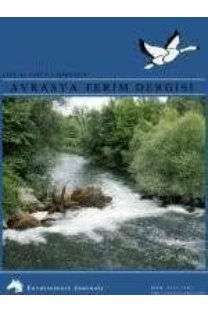TÜRKİYE’DE KULLANILMAKTA OLAN PALİNOLOJİ VE POLEN TERİMLERİ ÜZERİNE BİR DEĞERLENDİRME VE ÖNERİLER
AN ASSESSMENT AND RECOMMENDATIONS ON PALYNOLOGY AND POLLEN TERMS USED IN TURKEY
___
Aslan, M., Doğan, C., 2012. Türkiye’deki Hyoscyamus L. (Solanaceae) Türlerinin Polen Morfolojisi. KSÜ Doğa Bil. Derg., 15 (1): 20-29.Avcı, S., Sancak, C., Can, A., Acar, A., Pınar, N.M., 2013. Pollen morphology of the genus Onobrychis (Fabaceae) in Turkey. Turk J Bot. 37: 669-681.
Aytuğ, B., 1967. Polen Morfolojisi ve Türkiye’nin Önemli Gymnospermleri Üzerinde Palinolojik Araştırmalar. İstanbul: Kutulmuş Matbaası.
Aytuğ, B., Aykut, S., Merev, N., Edis, G., 1971. İstanbul Çevresi Bitkilerinin Polen Atlası. İstanbul: İ.Ü. Orman Fakültesi Yayınları No: 174, Kurtulmuş Matbaası.
Aytuğ, B., Merev, N., 2002. Palinoloji Ders Notu. Trabzon: Karadeniz Teknik Üniversitesi, Orman Fakültesi, Ders Notları No:67.
Baldemir, A., Alan, Ş., Acar Şahin, A., Paksoy, M.Y., Pınar, N.M., 2018. Pollen morphology of Scaligeria DC. (Apiaceae) in Turkey. Turk J. Bot. 42: 462-477.
Beug H.J., 2004. Leitfaden der Pollenbestimmungfür Mitteleuropa und angrenzendeGebiete. Dr Friedrich Pfeil, München.
Doğan Güner, E., Duman, H., Pınar, N.M., 2011. Pollen morphology of the genus Seseli L.(Umbelliferae) in Turkey. Turk J. Bot. 35: 175-182.
Erdtman, G., 1943. An Introduction to Pollen Analysis. Chronica Botanica Co., Waltham, Mass., 239.
Erdtman, G., 1945. Pollen morphology and plant taxonomy: III. Morina L. Sven. Bot. Tidskr. 39: 187– 191.
Erdtman, G., 1947. Suggestions for the classification of fossil and recent pollen grains and spores. Sven. Bot. Tidskr. 41: 104–114.
Erdtman, G., 1952. Pollen Morphology and Plant Taxonomy (An Introduction to Palynology, 1). Chronica Botanica Co., Waltham, Mass., 539.
Erdtman, G., 1954. An Introduction to Pollen Analysis. Chronica Botanica Co., Waltham, Mass., 239.
Erdtman, G., 1969. Handbook of Palynology—An Introduction to the Study of Pollen Grains and Spores. Munksgaard, Copenhagen. 486.
Faegri, K. Iversen, J., 1950. Textbook of Modern Pollen Analysis. Munksgaard, Copenhagen, 168.
Fægri, K., 1956. Recent trends in palynology. Bot. Rev. 22: 639–664.
Fernandez-Moran, H., Dahl, A. O., 1952. Electron microscopy of ultra-thin frozen sections of pollen grains. Science, 116:465.
Fritzsche, J., 1837. Über den Pollen. Mém. Sav. Étrang. Acad. Sci. Pétersbourg 3: 649–672.
Hyde, H.A., 1944. Pollen analysis and the museums. Mus. J. 44: 145–149.
Iversen, J., Troëls-Smith, J., 1950. Pollen morfologiskedefinitionerogtyper. Danmarks Geol. Undersogelse, IV, 3(8): 1-53.
Jackson, D.D., 1928. A Glossary of Botanic Terms. 4th ed. Duckworth.
Karlıoğlu Kılıç, N., Yilmaz Dağdeviren, R., Paksoy, M.Y., Tuncalı Yaman, T., 2020. Pollen morphology of eight endemic Inula L. (Asteraceae) species in Turkey. Palynology, https://doi.org/10.1080/01916122.2020.1784306.
Linnaeus, C., 1750. Philosophy of Botany. Stockholm. (‘1751’) 362.
Manten, A.A., 1966. Half a century of modern palynology. Earth-Sci. Rev. 2: 277–316
Maurizio, A., Louveaux, J., 1960. Pollens des plantesMellifèresd'Europe. Pollens Spores 2: 159– 182.
McAndrews J.H., Berti A.A., Norris, G., 1973. Key to the Quaternary Pollen and Spores of the Great Lakes Region. Life Science Miscellaneous Publication, Royal Ontario Museum, Toronto.
Mühlethaler, K., 1953. Untersuchungenüber die Struktur der Pollenmembran. Mikroskopie, 8: 103.
Moore P.D., Webb J.A., 1978. An Illustrated Guide to Pollen Analysis. Hodder & Stoughton, London.
Moore P.D., Webb J.A, Collinson M.E., 1991. Pollen Analysis. 2nd edn. Blackwell Scientific Publications, Oxford.
Özler, H., Pehlivan, S., Celep, F., Doğan, M., Kahraman, A., Yavru Fişne, A., Başer, B., Bagherpour, S., 2013. Pollen morphology of Hymenosphace and Aethiopis sections of the genus Salvia (Lamiaceae) in Turkey. Turk J. Bot. 37: 1070-1084.
Pınar, N.M., Coskuncelebi, K., Simsek, D., Okur, S., Makbul, S., Acar, A., 2016.Pollen morphology of Scorzonera (Asteraceae) in Turkey. Phytotaxa 252 (4): 233–262.
Potonié, R., 1934. I. ZurMorphologie der fossilen Pollen und Sporen. Arb. Inst. Paläobotanik PetrographieBrennsteine 4: 5–24.
Punt, W., Blackmore, S., Clarke G.C.S., 1976-2009. The North-West European Pollen. Flora volumes 1-9. Elsevier, Amsterdam.
Punt, W., Hoen, P.P., Blackmore, S., Nilsson, S., Thomas, A.L., 2007. Glossary of pollen and spore terminology. Rewiev of Palaeobotany& Palynology, 143: 1-81.
Selling, O., 1947. Studies in Hawaiian pollen statistics. Bernice P.Bishop Mus. Spec. Publ. 38: 1–430.
Walker, J.W., Doyle, J.A., 1975. The bases of angiosperm phylogeny: palynology. Ann. Mo. Bot. Gard. 62: 664–723.
Wodehouse, R.P., 1928. The phylogenetic value of pollen grain characters. Ann. Bot. 42: 891–934.
Wodehouse, R. P., 1935. Pollen Grains. Their Structure, Identification and Significancein Science and Medicine. McGraw-Hill, New York, N.Y., 574.
Yıldırımlı, Ş., 2015. Bitki Sözlüğü-Ansiklopedik ve Etimolojik, Çoğunluğu Latince, Yunanca, Almanca, Fransızca, İngilizce, Osmanlıca Karşılıklarıyla Türkçe Açıklamalı 13050 Sözcük ve Terim. Ankara: Ofset Fotomat Matbaacılık.
- ISSN: 2147-7507
- Yayın Aralığı: 3
- Başlangıç: 2013
- Yayıncı: Orhan Sevgi
Katı Atık Yönetiminde Kullanılan Bazı Kavramlar ve Açıklamaları
Türkiye’de Kullanılmakta Olan Palinoloji ve Polen Terimleri Üzerine Bir Değerlendirme ve Öneriler
Nurgül KARLIOĞLU KILIÇ, Rüya YILMAZ DAĞDEVİREN, Hülya CANER, Ünal AKKEMİK
Gölyaka İlçesinde (Düzce) Yerel Halk Tarafından Kullanılan Bitkilerin Yöresel İsimleri
Aynı Dili Konuşmak: Trafik Mühendisliğinde Akım Oranı Nedir?
GÖLYAKA İLÇESİNDE (DÜZCE) YEREL HALK TARAFINDAN KULLANILAN BİTKİLERİN YÖRESEL İSİMLERİ
Ayla KÖYSAL, Ernaz Altundağ ÇAKIR
AYNI DİLİ KONUŞMAK: TRAFİK MÜHENDİSLİĞİNDE AKIM ORANI NEDİR?
KATI ATIK YÖNETİMİNDE KULLANILAN BAZI KAVRAMLAR VE AÇIKLAMALARI
TÜRKİYE’DE KULLANILMAKTA OLAN PALİNOLOJİ VE POLEN TERİMLERİ ÜZERİNE BİR DEĞERLENDİRME VE ÖNERİLER
Nurgül KILIÇ, Rüya YILMAZ DAĞDEVİREN, Hülya CANER, ÜNAL AKKEMİK
